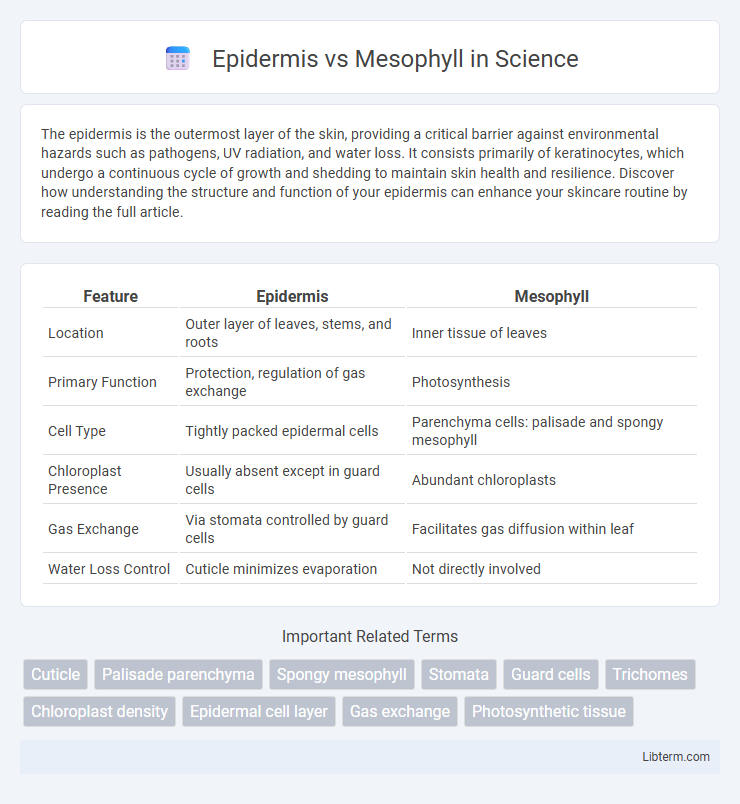The epidermis is the outermost layer of the skin, providing a critical barrier against environmental hazards such as pathogens, UV radiation, and water loss. It consists primarily of keratinocytes, which undergo a continuous cycle of growth and shedding to maintain skin health and resilience. Discover how understanding the structure and function of your epidermis can enhance your skincare routine by reading the full article.
Table of Comparison
| Feature | Epidermis | Mesophyll |
|---|---|---|
| Location | Outer layer of leaves, stems, and roots | Inner tissue of leaves |
| Primary Function | Protection, regulation of gas exchange | Photosynthesis |
| Cell Type | Tightly packed epidermal cells | Parenchyma cells: palisade and spongy mesophyll |
| Chloroplast Presence | Usually absent except in guard cells | Abundant chloroplasts |
| Gas Exchange | Via stomata controlled by guard cells | Facilitates gas diffusion within leaf |
| Water Loss Control | Cuticle minimizes evaporation | Not directly involved |
Introduction to Epidermis and Mesophyll
The epidermis is the outermost cell layer of plant leaves, providing protection and regulating gas exchange through stomata. Mesophyll, located beneath the epidermis, contains chloroplast-rich cells specialized for photosynthesis, divided into palisade and spongy mesophyll types. This structural differentiation facilitates efficient light absorption and gas diffusion critical for plant metabolism.
Structural Differences Between Epidermis and Mesophyll
The epidermis is a single layer of tightly packed cells that form the outermost protective barrier of leaves, preventing water loss and shielding against pathogens. In contrast, the mesophyll consists of multiple layers of loosely arranged parenchyma cells specialized for photosynthesis, divided into palisade mesophyll with elongated cells rich in chloroplasts and spongy mesophyll with irregular cells and air spaces to facilitate gas exchange. These structural differences reflect the epidermis's role in protection and regulation, while the mesophyll adapts to maximize light absorption and carbon dioxide diffusion.
Location in Plant Anatomy
The epidermis is the outermost layer of cells covering the leaves, stems, and roots, serving as a protective barrier against environmental stress. In contrast, the mesophyll is located beneath the epidermis within the leaf, consisting of palisade and spongy cells that facilitate photosynthesis. The spatial arrangement of these tissues optimizes light absorption and gas exchange critical for plant metabolism.
Primary Functions of Epidermis
The epidermis primarily serves as a protective barrier, preventing water loss and shielding internal tissues from pathogens and mechanical injury. It regulates gas exchange through specialized structures like stomata and controls transpiration in leaves. Unlike the mesophyll, which is specialized for photosynthesis, the epidermis focuses on maintaining plant integrity and environmental interaction.
Primary Functions of Mesophyll
Mesophyll primarily functions as the site of photosynthesis, containing chloroplasts that capture sunlight to convert carbon dioxide and water into glucose and oxygen. It is divided into palisade mesophyll, which is densely packed for maximum light absorption, and spongy mesophyll, which facilitates gas exchange through its porous structure. This tissue plays a critical role in energy production and supports overall plant growth and metabolism.
Cell Types in Epidermis vs Mesophyll
The epidermis consists primarily of tightly packed, flat epidermal cells that form a protective outer layer, along with specialized guard cells that regulate gas exchange through stomata and trichomes that offer defense against herbivores. In contrast, the mesophyll is composed mainly of two types of parenchyma cells: palisade mesophyll cells, which are elongated and rich in chloroplasts for photosynthesis, and spongy mesophyll cells, which have a loose arrangement to facilitate gas diffusion. The structural differences in cell types between the epidermis and mesophyll reflect their distinct functions in protection and photosynthesis, respectively.
Role in Photosynthesis
The epidermis acts as a protective barrier that regulates gas exchange and minimizes water loss, crucial for maintaining the optimal internal environment for photosynthesis. The mesophyll contains chloroplast-rich cells where the majority of photosynthesis occurs, capturing light energy to synthesize glucose. Specialized structures within the mesophyll, including palisade and spongy cells, optimize light absorption and facilitate efficient gas diffusion essential for photosynthetic reactions.
Adaptations and Specializations
The epidermis features a waxy cuticle and stomata for water retention and gas exchange, preventing desiccation in various environments. Mesophyll cells, divided into palisade and spongy layers, specialize in photosynthesis with chloroplast-rich palisade cells maximizing light absorption and spongy cells facilitating gas diffusion. These adaptations optimize plant efficiency in resource use, supporting survival and growth under diverse environmental conditions.
Importance in Plant Physiology
The epidermis serves as the protective outer layer of plant organs, preventing water loss and providing a barrier against pathogens, which is crucial for maintaining overall plant health. Mesophyll cells, primarily found in leaves, are specialized for photosynthesis, containing chloroplasts that efficiently convert light energy into chemical energy, driving growth and development. Together, the epidermis and mesophyll coordinate to optimize gas exchange and water retention, ensuring effective photosynthetic activity and plant survival.
Summary: Key Differences and Similarities
The epidermis serves as the outer protective layer of leaves, composed primarily of tightly packed cells that minimize water loss and provide a barrier against pathogens, while the mesophyll is the internal tissue responsible for photosynthesis, containing chloroplast-rich palisade and spongy cells that facilitate gas exchange and light absorption. Both tissues contribute to overall leaf function by maintaining structural integrity and enabling photosynthetic efficiency through specialized roles in protection and nutrient processing. Key differences include the epidermis's lack of chloroplasts versus the mesophyll's abundance of chloroplasts, and the epidermis's primarily protective function compared to the mesophyll's central role in photosynthesis.
Epidermis Infographic

 libterm.com
libterm.com